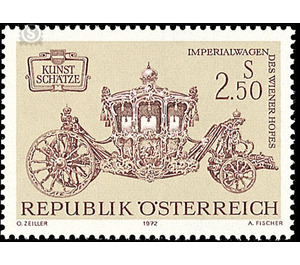art treasures - Austria / II. Republic of Austria 1972 - 2.50 Shilling
Theme: Traffic, Transportation & Mobility
| Country | Austria / II. Republic of Austria |
| Issue Date | 1972 |
| Face Value | 2.50 |
| Color | grey violet |
| Printing Type | combination printing |
| Stamp Type | Commemorative |
| Item Type | Stamp |
| Chronological Issue Number | 751 |
| Chronological Chapter | OOS-OE2 |
| SID | 934605 |
| In 65 Wishlists | |
The main feature of the Vienna Wagenburg is also the motif of the third special postage stamp of this series: the imperial car of the Viennese court. Popularly known as the Emperor or Coronation Car, its extraordinary dimensions - 6.77 meters in length, 3.55 meters in height and 4200 kilograms in weight - symbolize a castle where its owner is driven through the crowd. On the outside, the car has so-called panel paintings, depicting the virtues painted on the occasion of the coronation of Joseph II in 1763. According to the "Spanish style" the coachman was missing on the car, because the imperial car was steered from the saddle of the Imperial train (initially six, later even eight horses). Since the car had to be disassembled for transport and reassembled, he found only in the main house, court and state actions use.


